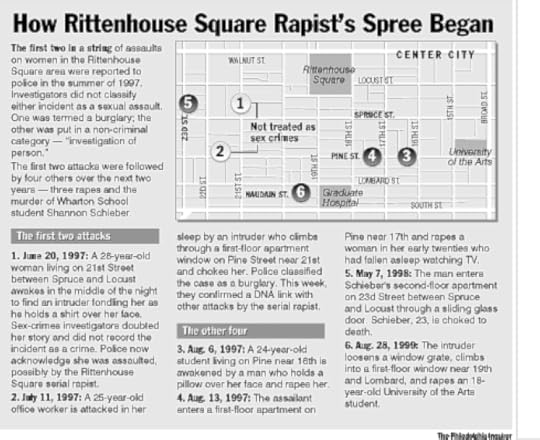Shannon Schieber
A lesson in classifying sex crimes, as sex crimes.
Shannon Schieber graduated from Duke in 3 years. She then attended Wharton College in Philadelphia and was pursuing her doctorate degree when a self-centered jerk cut her life short. May 7, 1998, Shannon was studying for her last 2 final exams of the school year. Shannon’s brother had planned on coming into Philadelphia to visit. She tells him she needs to study, and asks him to come the next day instead. A neighbor hears Shannon scream at 2:00 a.m., and calls the police. The police arrive within 6 minutes, but no one answers the door. The police consider breaking the door down, but the neighbor begins questioning if the sound was from the apartment or from outside. The police can’t break down the door based on an uncertain report. Shannon’s brother, Sean, arrives the next day. When she doesn’t answer, he and the neighbor break down the door and find her dead, lying naked on the bed. Shannon was an assertive and attractive young woman attending a program that was predominantly male, so at times this put her at odds with peers. She told a man she had dated that she wanted to remain friends. He tells her, “The next funeral you may attend may be your own.” Shannon gets a restraining order. The investigators bring this guy in for DNA testing but have to release him until the results return.
Shannon was an assertive and attractive young woman attending a program that was predominantly male, so at times this put her at odds with peers. She told a man she had dated that she wanted to remain friends. He tells her, “The next funeral you may attend may be your own.” Shannon gets a restraining order. The investigators bring this guy in for DNA testing but have to release him until the results return.
At Shannon’s funeral, one of the investigators tells her parents they suspect the killer may be at her funeral. Shannon had an intense argument with a young man, only days before her death, and here he is. They interrogate him, but without evidence have to release him. The family is frustrated that a potential killer is released. The DNA tests finally come back on both men. Neither of these men killed Shannon.
Here is why you should classify crimes correctly:
A friend of Shannon’s tells investigators that a man had followed Shannon home from a movie, days before her death. Investigators then theorize that maybe Shannon wasn’t this guy’s first victim. Initially investigators can’t find any similar sexual crimes. They run the DNA and find a match to “burglaries” in the area. Once they look at the “burglaries” they realize they were sexual assaults, but they were charged as burglaries. It reveals a problem in the Philadelphia police department. They had been charging sex crimes as burglaries in an effort to make it look like sex crimes were lower, and to keep their arrest rate for sex crimes high. The police had covered up 4 previous rapes within 3 blocks of her home. Had the public been made aware of this, the community would have known there was a serial rapist on the loose, and could have been more cautious. The rapist shared with one of the victims that his mother is Italian American and his father is African American, which fits the description from other surviving victims. (Either dark white guy or light black guy—he was both.) Investigators made the information public. After August 1999, the Center City Rapist stops. In 2001, a woman working in the Philadelphia police department looks at news reports from Fort Collins, Colorado, on a serial rapist.
In 2001, a woman working in the Philadelphia police department looks at news reports from Fort Collins, Colorado, on a serial rapist.
Kristen Marshall’s husband was dying from cancer. He took his son on a last father and son camping trip and Kristen stays home. In the middle of the night a man breaks into her home. She complied as she didn’t want her son to lose both of his parents. He left her naked and tied to the bed. She managed to work herself loose and call the police. She’s told by police she’s been the 3rd woman in Fort Collins raped in a similar manner.
After the 5th attack, the killer left a baseball cap at the scene. DNA processing can be slow, and Philadelphia finally matches the DNA from Fort Collins to their crimes.
The suspect sends a letter to the Philadelphia police indicating he doesn’t like Fort Collins. He claims he didn’t kill Shannon. The Philadelphia police start cross referencing people who lived in both Philadelphia and Fort Collins. A woman in Fort Collins calls and reports that her neighbor, Troy Graves, looks like the sketch of the rapist. Graves is one of the 40 people on the list. He is married. He has high security clearance in Cheyenne, Wyoming, on an Air force base that deals with nuclear weapons. As they investigate Graves further, they find he lived in the neighborhood of all of the victims in Philadelphia and Fort Collins at the times of the assaults. His wife shares that he is gentle and she doesn’t believe he’s the rapist, but admits he struggles with insomnia and often needs to go for drives at night. Amy Wade, Troy’s wife, pictured below. Troy Graves told his wife both blacks and whites taunted him because he was of mixed race. His father, Earl Clayton Graves, a welder for General Motors, was a physically abusive heroin addict, according to both family members and Troy Graves' former partners. Graves' mother divorced Earl when Troy was 13. Troy Graves said his father, who died homeless, ignored him.
Troy Graves told his wife both blacks and whites taunted him because he was of mixed race. His father, Earl Clayton Graves, a welder for General Motors, was a physically abusive heroin addict, according to both family members and Troy Graves' former partners. Graves' mother divorced Earl when Troy was 13. Troy Graves said his father, who died homeless, ignored him.
Graves told Robinson that he had suffered extensive physical and mental abuse, and that he had been sexually molested. His molester would coerce him, he told his partner, as if the acts were mere affection: "Why don't you do this? You had a bad day. This will make you feel good. This will make me feel good." Graves victims reported he spoke to them in a similar manner.
Most people who suffer abuse do not go on to become violent themselves, but among people who do become violent criminals, it is a common factor.
Troy had been charged with harassing a female colleague in the Air Force, but had no legal charges. When interviewed, he denied the harassment allegation until he was confronted directly with it. Graves continues to deny being the rapist, but DNA evidence identifies him as the rapist and killer. Troy Graves pleads guilty in Colorado. The District Attorney in Philadelphia wants him to face the death penalty. However, Shannon’s parents don’t believe in the death penalty. They assert that they want him to wake up every day for the rest of his life in prison. Graves gets another life sentence, plus 60 years, in Philadelphia. Philadelphia attacks
Philadelphia attacks
1. June 20, 1997: a woman on South 21st Street is the target of an attempted rape by a home intruder;
2. July 11, 1997: a woman on Pine Street was raped by a home intruder;
3. August 6, 1997: a woman on Pine Street was raped by a home intruder;
4. August 13, 1997: a woman on Pine Street was raped by a home intruder;
5. May 7, 1998: Wharton School doctoral student Shannon Schieber was raped and murdered by a home intruder;
6. August 28, 1999: a woman on Naudain Street was forced to perform a sex act by a home intruder.
Fort Collins attacks
1. May 10, 2001: a woman on Raintree Drive was raped;
2. June 13, 2001: a woman on Raintree Drive was raped;
3. June 24, 2001: a woman on Battlecreek Drive was forced to perform a sex act by a home intruder;
4. July 26, 2001: a woman on Prospect Road was forced to perform a sex act by a home intruder;
5. August 5, 2001: a woman on University Avenue was raped by a home intruder;
6. August 23, 2001: a woman on Landings Drive was forced to perform a sex act by a home intruder; she scared him away after he then tried to attack her roommate. Now she is an impressive person! Graves was just one more self-centered slimeball.
Thanks for listening,
Frank I love the New Orleans jazz style SLO’s at the end. Mitch, Frank, Preston & Charlie at the New Bohemia Pub
Mitch, Frank, Preston & Charlie at the New Bohemia Pub 





















Shannon Schieber graduated from Duke in 3 years. She then attended Wharton College in Philadelphia and was pursuing her doctorate degree when a self-centered jerk cut her life short. May 7, 1998, Shannon was studying for her last 2 final exams of the school year. Shannon’s brother had planned on coming into Philadelphia to visit. She tells him she needs to study, and asks him to come the next day instead. A neighbor hears Shannon scream at 2:00 a.m., and calls the police. The police arrive within 6 minutes, but no one answers the door. The police consider breaking the door down, but the neighbor begins questioning if the sound was from the apartment or from outside. The police can’t break down the door based on an uncertain report. Shannon’s brother, Sean, arrives the next day. When she doesn’t answer, he and the neighbor break down the door and find her dead, lying naked on the bed.
 Shannon was an assertive and attractive young woman attending a program that was predominantly male, so at times this put her at odds with peers. She told a man she had dated that she wanted to remain friends. He tells her, “The next funeral you may attend may be your own.” Shannon gets a restraining order. The investigators bring this guy in for DNA testing but have to release him until the results return.
Shannon was an assertive and attractive young woman attending a program that was predominantly male, so at times this put her at odds with peers. She told a man she had dated that she wanted to remain friends. He tells her, “The next funeral you may attend may be your own.” Shannon gets a restraining order. The investigators bring this guy in for DNA testing but have to release him until the results return. At Shannon’s funeral, one of the investigators tells her parents they suspect the killer may be at her funeral. Shannon had an intense argument with a young man, only days before her death, and here he is. They interrogate him, but without evidence have to release him. The family is frustrated that a potential killer is released. The DNA tests finally come back on both men. Neither of these men killed Shannon.
Here is why you should classify crimes correctly:
A friend of Shannon’s tells investigators that a man had followed Shannon home from a movie, days before her death. Investigators then theorize that maybe Shannon wasn’t this guy’s first victim. Initially investigators can’t find any similar sexual crimes. They run the DNA and find a match to “burglaries” in the area. Once they look at the “burglaries” they realize they were sexual assaults, but they were charged as burglaries. It reveals a problem in the Philadelphia police department. They had been charging sex crimes as burglaries in an effort to make it look like sex crimes were lower, and to keep their arrest rate for sex crimes high. The police had covered up 4 previous rapes within 3 blocks of her home. Had the public been made aware of this, the community would have known there was a serial rapist on the loose, and could have been more cautious. The rapist shared with one of the victims that his mother is Italian American and his father is African American, which fits the description from other surviving victims. (Either dark white guy or light black guy—he was both.) Investigators made the information public. After August 1999, the Center City Rapist stops.
 In 2001, a woman working in the Philadelphia police department looks at news reports from Fort Collins, Colorado, on a serial rapist.
In 2001, a woman working in the Philadelphia police department looks at news reports from Fort Collins, Colorado, on a serial rapist. Kristen Marshall’s husband was dying from cancer. He took his son on a last father and son camping trip and Kristen stays home. In the middle of the night a man breaks into her home. She complied as she didn’t want her son to lose both of his parents. He left her naked and tied to the bed. She managed to work herself loose and call the police. She’s told by police she’s been the 3rd woman in Fort Collins raped in a similar manner.
After the 5th attack, the killer left a baseball cap at the scene. DNA processing can be slow, and Philadelphia finally matches the DNA from Fort Collins to their crimes.
The suspect sends a letter to the Philadelphia police indicating he doesn’t like Fort Collins. He claims he didn’t kill Shannon. The Philadelphia police start cross referencing people who lived in both Philadelphia and Fort Collins. A woman in Fort Collins calls and reports that her neighbor, Troy Graves, looks like the sketch of the rapist. Graves is one of the 40 people on the list. He is married. He has high security clearance in Cheyenne, Wyoming, on an Air force base that deals with nuclear weapons. As they investigate Graves further, they find he lived in the neighborhood of all of the victims in Philadelphia and Fort Collins at the times of the assaults. His wife shares that he is gentle and she doesn’t believe he’s the rapist, but admits he struggles with insomnia and often needs to go for drives at night. Amy Wade, Troy’s wife, pictured below.
 Troy Graves told his wife both blacks and whites taunted him because he was of mixed race. His father, Earl Clayton Graves, a welder for General Motors, was a physically abusive heroin addict, according to both family members and Troy Graves' former partners. Graves' mother divorced Earl when Troy was 13. Troy Graves said his father, who died homeless, ignored him.
Troy Graves told his wife both blacks and whites taunted him because he was of mixed race. His father, Earl Clayton Graves, a welder for General Motors, was a physically abusive heroin addict, according to both family members and Troy Graves' former partners. Graves' mother divorced Earl when Troy was 13. Troy Graves said his father, who died homeless, ignored him.Graves told Robinson that he had suffered extensive physical and mental abuse, and that he had been sexually molested. His molester would coerce him, he told his partner, as if the acts were mere affection: "Why don't you do this? You had a bad day. This will make you feel good. This will make me feel good." Graves victims reported he spoke to them in a similar manner.
Most people who suffer abuse do not go on to become violent themselves, but among people who do become violent criminals, it is a common factor.
Troy had been charged with harassing a female colleague in the Air Force, but had no legal charges. When interviewed, he denied the harassment allegation until he was confronted directly with it. Graves continues to deny being the rapist, but DNA evidence identifies him as the rapist and killer. Troy Graves pleads guilty in Colorado. The District Attorney in Philadelphia wants him to face the death penalty. However, Shannon’s parents don’t believe in the death penalty. They assert that they want him to wake up every day for the rest of his life in prison. Graves gets another life sentence, plus 60 years, in Philadelphia.
 Philadelphia attacks
Philadelphia attacks1. June 20, 1997: a woman on South 21st Street is the target of an attempted rape by a home intruder;
2. July 11, 1997: a woman on Pine Street was raped by a home intruder;
3. August 6, 1997: a woman on Pine Street was raped by a home intruder;
4. August 13, 1997: a woman on Pine Street was raped by a home intruder;
5. May 7, 1998: Wharton School doctoral student Shannon Schieber was raped and murdered by a home intruder;
6. August 28, 1999: a woman on Naudain Street was forced to perform a sex act by a home intruder.
Fort Collins attacks
1. May 10, 2001: a woman on Raintree Drive was raped;
2. June 13, 2001: a woman on Raintree Drive was raped;
3. June 24, 2001: a woman on Battlecreek Drive was forced to perform a sex act by a home intruder;
4. July 26, 2001: a woman on Prospect Road was forced to perform a sex act by a home intruder;
5. August 5, 2001: a woman on University Avenue was raped by a home intruder;
6. August 23, 2001: a woman on Landings Drive was forced to perform a sex act by a home intruder; she scared him away after he then tried to attack her roommate. Now she is an impressive person! Graves was just one more self-centered slimeball.
Thanks for listening,
Frank I love the New Orleans jazz style SLO’s at the end.
 Mitch, Frank, Preston & Charlie at the New Bohemia Pub
Mitch, Frank, Preston & Charlie at the New Bohemia Pub 





















Published on February 04, 2019 07:49
No comments have been added yet.



